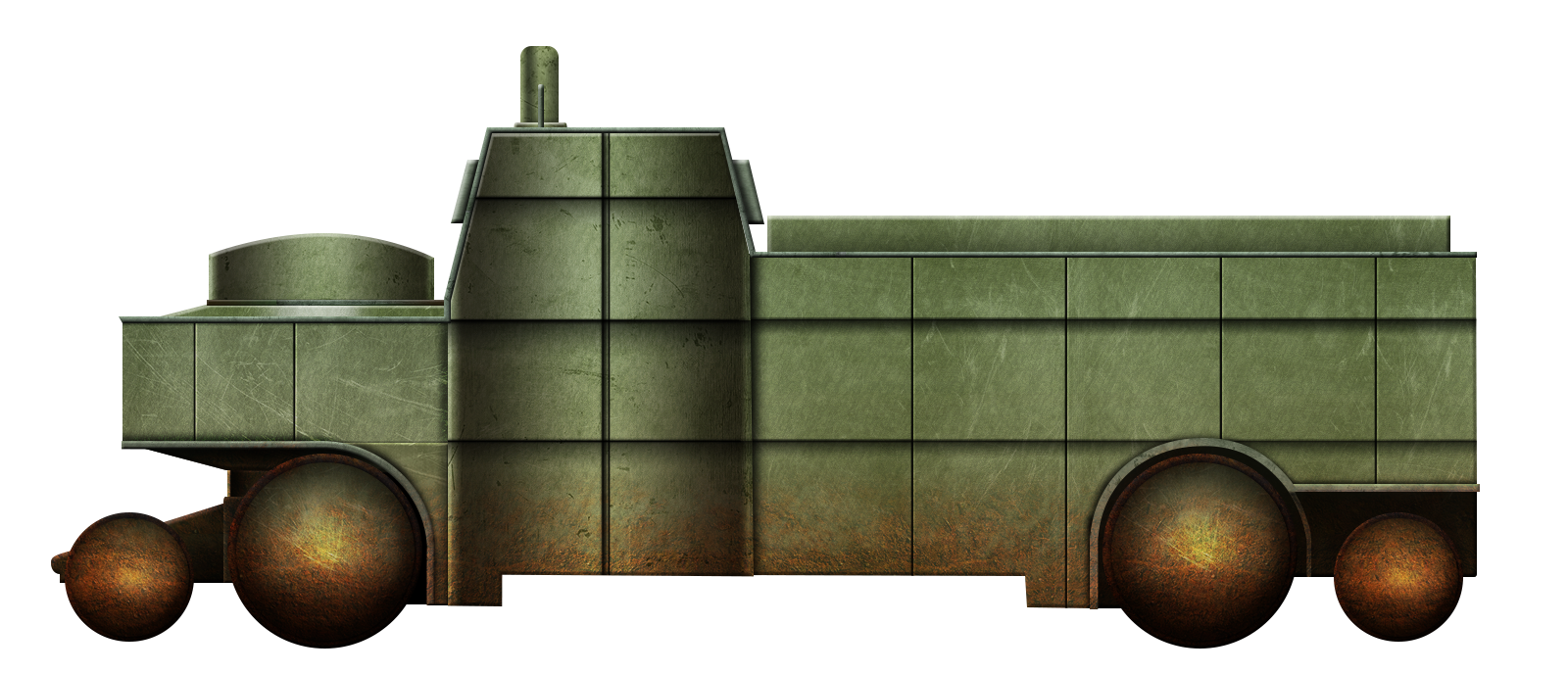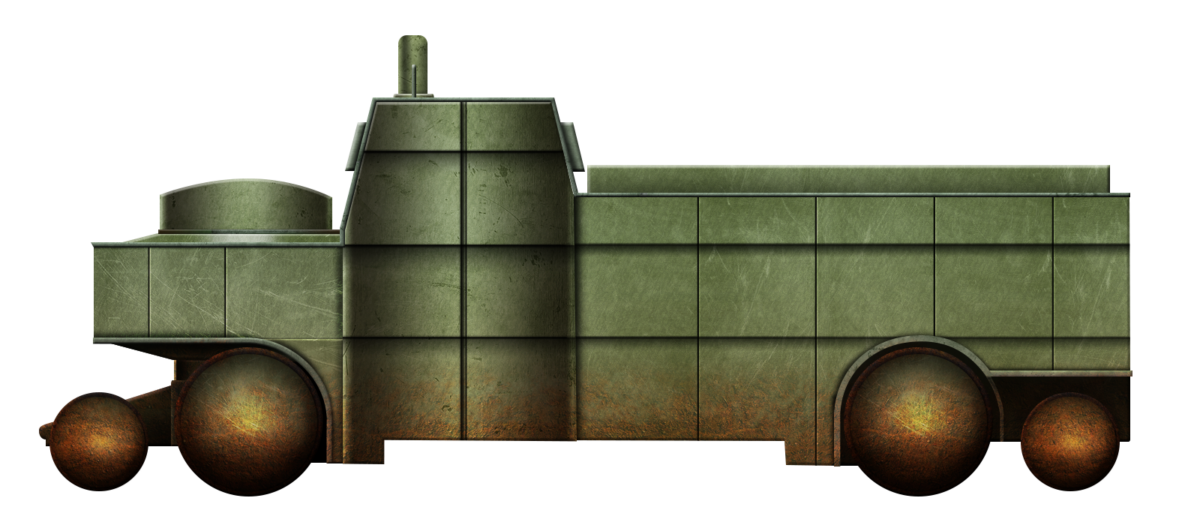 Austro-Hungarian Empire (1913)
Austro-Hungarian Empire (1913)
Armored Car – 1 Prototype Built
In 1913, just a year before World War I broke out, an armored car was built in the Austro-Hungarian Empire, designed by an artillery officer named Franz Wimmer. Although a patent has survived, as well as some scarce reports in contemporary newspapers, further documentation, including photographs, are unknown. In fact, relevant literature has not even mentioned the armored vehicle. This article hopefully will increase awareness of this specific part of Austro-Hungarian armored history.

The Place of Armored Vehicles in Austria-Hungary
The Austro-Hungarian Empire has a dubious place in early armored vehicle development. On one hand, its soil brought forth the advanced 4×4 Austro-Daimler Panzerautomobil in 1905, and the famous Motorgeschütz design by Burstyn which was never built but has been dubbed as one of the theoretical forerunners of the tank that would appear on the battlefield during the First World War. On the other hand, the Austro-Hungarian Army rejected all these designs and went to war in 1914 without any armored vehicle when it could potentially have had the best of its time. As such, the Austro-Hungarian Army has often been criticized for having overlooked the value of armored vehicles. Partially, this is true. The Austro-Daimler Panzerwagen was rejected for dubious reasons and when the Romfell armored car was built in 1915, the Ministry of Defense was initially furious that a truck chassis was ‘wasted’. However, one should not forget that the Austro-Daimler was actually based on requirements laid out by the Army itself, that the Motorgeschütz was rejected based on reasonable arguments and that, apparently, a new armored vehicle was trialed in 1913.
The Designer
Little information has been found about Franz Wimmer, mainly because the right information is hard to find, due to Franz Wimmer being a common name in Austria. He served as an officer within the 4th Field Gun Regiment (4. Feldkanonenregiment, F.K.R. 4 for short) when he applied for his patent. During early April 1913, Oberleutnant Wimmer was awarded the Marianerkreuz by Erzherzog Eugen as a reward of merit for his work in sanitary techniques. Sometime after this, at the very end of April or early May, he was promoted to Hauptmann, similar to the rank of captain. In July, he received the ‘Fürstlich Liechtensteinische Regierungsjubiläums Erinnerungsmedaille’, followed by the Jerusalem Pilgrim’s Cross which he received in August 1914. At the end of 1914, when the war had already been going on for several months, Wimmer made the news again thanks to another invention of his, namely a special water-resistant coat for horse riders to protect them during heavy rain. This invention he had already patented several years earlier. Apart from that achievement, the records have been silent about Hauptmann Franz Wimmer.

The Design
*Note to reader: This description is based on the patent description. To what extent the patent matched the built vehicle is not fully known*
The patent described the vehicle as follows:
“The object of this invention is an armored car which is essentially characterized by the placement of the armed turret and by extendable bridge-like truss beams or preferably extension frames with auxiliary wheels for crossing trenches.”
A turnable turret was mounted at the front of the vehicle. A machine gun or a gun of small caliber could be mounted on a pivot to which the gunners’ seat was attached.
Behind the turret, a higher built armored compartment was located which housed a commander and a driver. A foldable chair was located on the front side on which the driver could sit when driving backward. Because this compartment was higher than the turret in front, this provided both the commander and driver a good surround-view without limiting the firing radius too much. Furthermore, Franz Wimmer believed that the crew would get irritated by gunfire that would be fired above or over their heads. With this design, it was not possible to fire over the crew compartment.
At the back compartment of the vehicle, additional machine guns could be deployed in the event of an attack at the rear or if the vehicle would have to ride backward. The engine was located at the center of the vehicle and coupled with a dynamo. A cooler was placed on top with a fan. To ease repairs, the sides of the engine compartment could be detached. Furthermore, an accumulator was placed in the rear compartment from which power could be sourced in case the engine would fail. Furthermore, this compartment held the gasoline tanks, ammunition storage, as well as several stretchers for the wounded.
In an attempt to decrease total weight, the armor was made of relatively weak and small armored plates overlapping each other in a roof tile-like manner. The plates were 3 mm thick, not even bulletproof, and 60 by 40 cm in size. The patent described the armor to be made of any suitable steel, but preferably an alloy of Nickel-Chrome-Vanadium. The armor plates were attached to the wall with eyelets and wire ropes. With springs, they were individually supported and held in an inclined position.

Extendable Beams
One starts to wonder if it is a coincidence that Franz Wimmer implemented the idea of crossing beams while his compatriot, Günther Burstyn, had thought of the exact same thing some years back, albeit differently executed. As Burstyn published his design in contemporary military magazines, it is plausible that Franz Wimmer was aware of Burstyn’s idea, but this remains speculation. We only know that they served the same purpose, namely to overcome the difficulty wheeled vehicles had with crossing ditches and trenches. And, just like Burstyn’s design, the idea would have been hard to operate, if not impossible.

The vehicle was not specifically meant for combat. Listed usages were as ammunition and supply carrier, as a reconnaissance vehicle in hostile territory, and as rapid deployment of firepower, as 3-4 machine guns could be mounted on the vehicle. Furthermore, the electric power could have a variety of uses in wartime, including providing power for a telegraphy station. The headlight on the front provided enough light to enable operation at nighttime.
In the Press
On May 11, 1913, the Pilsner Tagblatt reported that, at that time, a Panzerautomobil was trialed. If the vehicle lived up to expectations, a few would be acquired by the War Administration. The Deutscher Volksblatt, on May 8, was more informative and knew that the vehicle was armored with nickel steel plating and that the extendable trench crossing beams were its special novelty. The most extensive report appeared in the Prager Tagblatt of May 11. They added that both the specific construction and the multitude of uses were praised by the professional circles. Furthermore, the article listed several of the technical specifications.
The vehicle was constructed at the Austro-Daimler factory in Wiener-Neustadt. The Austro-Daimler Panzerautomobil of 1905 had been built by the very same factory. Unfortunately, it is not known how well the Wimmer Panzerautomobil performed. It was never ordered by the Army and, by that, it can be assumed the vehicle did not live up to expectations, however, to which extent cannot be said without further sources.

Conclusion
With the extendable beams and sloped and suspended armor plating, Franz Wimmer designed a unique armored car. Unfortunately, history has not done much good to the vehicle, as it is practically unknown, partially due to the complete lack of photographs. Future research will hopefully shed more light on this obscure piece of Austro-Hungarian armored history and its trials.

Illustration of the Franz Wimmer Panzerautomobil by Yuvnashva Sharma, funded by our Patreon campaign.
Specifications |
|
| Crew | 3 (Commander, driver, gunner) + additional machine gunners |
| Armament | 3-4 machine guns |
| Armor | 3 mm nickel plates |
Sources
AT Patent AT66567B Panzerautomobil, filed 22 February 1913, granted 15 April 1914.
Versuche mit einem Panzerauto, page 8, Deutsches Volksblatt, 8 May 1913, (Link).
Ein Panzerautomobil, page 6, Pilsner Tagblatt, 11 May 1913, (Link).
Daß Austro-Daimler Panzerautomobil, page 9, Prager Tagblatt, 11 May 1913, (Link).
Personalnachrichten, page 7, Fremden-Blatt, 5 April 1913 (Link).
Aus dem Verordnungsblatt für das heer, page 5, Neues Wiener Abendblatt, 26 July 1913, (Link).
Aus dem Verordnungsblatt für das K.u.K. Heer nr.42, page 14, Fremden-Blatt, 7 August 1914, (Link).
Eine Erfindung des Artilleriehauptmanns Wimmer, page 22, Streffleur’s Militärblatt, 14 November 1914, (Link).
All newspapers have been accessed at anno.onb.ac.at
All patents have been accessed at worldwide.espacenet.com


One reply on “Franz Wimmer Panzerautomobil”
Look how blocky it looks